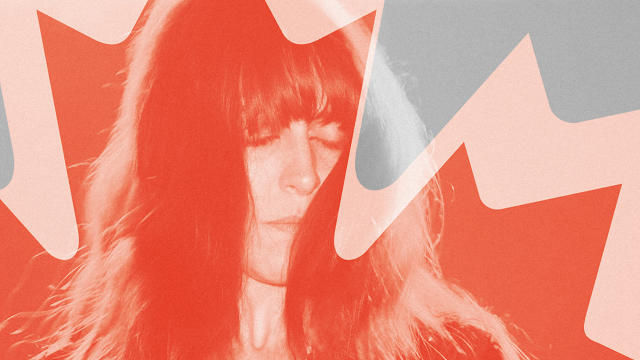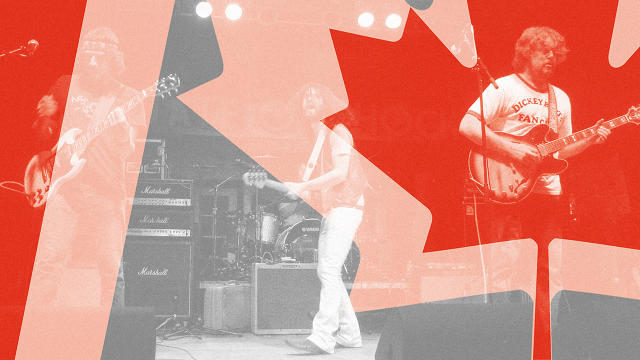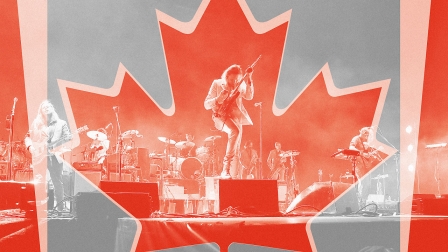How Canada’s Philanthropic Pop Industrial Complex Took Over The World
Six years ago, Abel Tesfaye was just another musician making mixtapes and distributing songs for free on YouTube. Then Drake tweeted about him, fans went nuts, and—as the rock lore so often goes—he ascended from virtually nowhere to claim the celebrity throne. In February, Tesfaye—now far better known by his stage name, The Weeknd—was nominated for five Grammies and won two, including best R&B song for “Earned It,” originally written for the movie Fifty Shades of Grey, and best R&B album for Beauty Behind the Madness, which included that song and two more, “Can’t Feel My Face” and “The Hills,” both also top Billboard hits.
Except the story isn’t quite as romantic as that. Tesfaye isn’t from nowhere. He’s from Canada (Toronto, to be exact). And his rise wasn’t just the result of a fortuitous tweet from a fellow Canuck. It was all part of a plan to create a musical super-scene, orchestrated by the Canadian government.
And the plan is working. In case you haven’t been thinking a whole lot about the origin of your earworms these days, remember this refrain: Many, many, many of them have probably been imported from our neighbor to the north. At one point last year, Canadians took the top four spots on the Billboard Hot 100 for the first time in the chart’s 60-year history. Then a few months later the country secured a popular majority, taking 7 of the top 10 Hot 100 spots.
Those current accolades ride on the work of stars like The Weeknd, Drake, Justin Bieber, Shawn Mendes, and Alessia Cara. Then there’s the continuous-if-formulaic drone from Nickelback, Avril Lavigne, Nelly Furtado, or Barenaked Ladies. And more work from Arcade Fire, Feist, Bahamas, Carly Rae Jepson, Marianas Trench, the Sheepdogs, or the Strumbellas, who recently hit No. 1 on Billboard’s alternative chart. Break that last list of artists out by genre and it covers pretty much every en vogue musical subcategory: indie rock, folk rock, just-plain-folk, teen pop, punk/emo, blues rock, and alt-country, respectively. In 2015, the Canadian Federation of Musicians reports nearly 1,600 acts crossed the border to tour in the U.S., about a third more than the average five years ago. For South by Southwest, the country now formally exports around 120 about-to-break groups, about double what it did a decade ago. In a way, Canada is essentially a pop music industrial complex, popping out an endless array of acts you love—or maybe just can’t tune out. All of which begs the question: How are so many making it big?

The X Factor
For his part, Tesfaye, like many before him, used his early recognition to tap into two major music funding philanthropies that are supported by the Canadian government and designed to help native acts control their own careers and achieve rock stardom. After he blew up on social media, CP—the small Canadian label Tesfaye was working with—secured $102,000 from the Foundation Assisting Canadian Talent on Recordings (FACTOR) to help produce and market his first studio album, Trilogy, in 2012. A year later, Tesfaye and the label secured another $97,000 from FACTOR to push out and publicize a second, Kiss Land. Tesfaye also received $101,000 over the course of two years from Radio Starmaker, another group that aides artists with marketing and touring costs. He joins a familiar chorus. Arcade Fire, Feist, Bahamas, Carly Rae Jepson, Marianas Trench, the Sheepdogs, or the Strumbellas—every one of them had funding from the same sources. (All the figures here are in Canadian dollars.)
Today, like The Weeknd, CP isn’t so small anymore—one of the guys behind it, who is The Weeknd’s co-manager, is reportedly being wooed by Maverick, the management company for Madonna and U2. “Our contribution was significant, and might have been critical to the early development of an artist with one of the major sound recording companies in Canada,” says FACTOR president Duncan McKie, who notes that The Weeknd just wrapped a multimillion dollar U.S. tour. “That kind of made them. It’s a good example of an investment we made that did pay off over the long term in the best way possible.”
Last year, FACTOR handed out $17 million to those who build the music industry: artists, managers, labels, publishers, distributors, and event producers. That includes about $4 million in direct business support to companies and so-called collective initiatives like the Juno Awards, Canada’s version of the Grammys. With the rest, the group funded the fame-building efforts of 1,000 artists, including paying for 580 recordings. In some cases, the rewards were staggered, allowing the group to essentially take larger risks on those who got traction as their popularity spiked. During the same period, Radio Starmaker spent nearly $10 million to help artists and labels promote and perform their albums. Part of that went to trade groups, like the Canadian Independent Music Association, which brings a delegation of bands to play SXSW, but most of it went directly to 128 musicians, many of whom re-applied for more rounds of funding as their sales took off.
Both agencies have strict rules, requiring bands to do things like audit their previous financial success and popularity, draw up solid business plans, and guarantee to spend a significant amount of their money co-investing in their own success. FACTOR only funds 50% to 75% of most project costs. Starmaker may match a major label’s investment or double that of an indie—and gives mostly to the latter. “It empowers these acts to run their own careers,” says Chip Sutherland, executive director at Radio Starmaker. “So when the record breaks, they aren’t walking around L.A. signing shitty record and management deals because that’s all they got.”
Some Canadian mega-artists—like Drake or Justin Bieber—have skipped this launchpad. But that doesn’t mean they weren’t influenced by the creative community around them. “The fact that there might not be a linear relationship between the Starmaker Fund [giving money] and Drake being successful? We are not trying to create linear relationships. We are just seeding the lawn, fertilizing the ground to see what grows,” says Sutherland. He sees this as a sort of grand experiment in the economy-building theory of social cohesion. By giving the community more tools and outlets for creative expression, it might end up stronger and more profitable for everyone.

Maple Radio
The Canadian government got into the business of homegrown hit making in the mid-’80s, about the same time “Physical” by Australian Olivia Newton was tearing up the country’s charts. “Not to say Olivia Newton John wasn’t a good artist, but you’d have to go halfway down the list to find some Canadians,” says McKie. To change the radio experience, the Canadian Radio-Television and Telecommunications Commission had passed the Music Artist Performance and Lyrics system or MAPL, which mandates that Canadian stations dedicate at least 35% of peak hours to Canadian-bred acts. (That quota is slightly lower for oldies stations, because the Canadian pop music canon, which includes Rush and Joni Mitchell, isn’t that deep.)
Still, officials learned that while an emerging artist like Bryan Adams might do well, it wasn’t really enough to inspire a Canadian pride movement. MAPL would only work if listeners weren’t trapped hearing the same songs over and over and over. You can only enjoy so much Bryan Adams. So the Department of Canadian Heritage began collecting one-half of a percentage point on all radio station revenue to bolster what’s now called the Canada Music Fund, which began distributing money to FACTOR in 1986. In their early days, acts like Alanis Morissette, Sarah McLachlan, and Nickelback all earned FACTOR grants. “It wasn’t altruism,” McKie says. “You need variety and good quality. It was in everyone’s interest to make that happen, and realism dictated that you just couldn’t do that with the resources at the time.”
Today, the group has a dozen or so different programs, which range from a couple thousand dollar grants for artists to make and promote a professional one-song demo or ten thousand bucks to help a new record company build its website, cover professional dues, and invest in sales and royalty tracking software. At the high end, grants can run to nearly six figures to pay for album creation and marketing, which can be piggybacked with several tens of thousands more in touring and showcase funds. To apply, artists fill out an online profile with info about how many albums they’ve put out, how they’ve sold, and how often they’re touring for how much per stop (record companies can also apply). There’s also a popularity tracker, which takes into account Facebook likes, Twitter followers, and YouTube views, ensuring there’s a fan base to support them. This info leads to three-tiered internal rating, which determines where the funding will be capped.
The barrier for the top-tier is fairly high. Everything’s graded on a curve, so only the top tier is eligible for the maximum $75,000 in initial album funding. Recently, that means they’ve sold 23,000 units (a measurement that combines physical albums sales with various digital offerings) of two albums within the last five years; are on track to make $116,000 over 43 tour dates; and have at least one song already on commercial radio. For social media parity, that should look like a base of 47,000 Facebook likes, 32,500 Twitter followers, and 520,000 YouTube video views. (The lower tiers require fewer sales and followers; if an artist isn’t doing well, they can reapply for a lower tier).
By making applications about raw data, FACTOR can fund groups proven to have small but loyal audiences, say, fiddle artists from Breton Island and an Inuit throat singer from Manitoba. (Her name is Tanya Tagaq, and she has 11,700 followers on Twitter.) “We put our money where our throats are, so to speak,” McKie jokes.
Say you just finished an album in your basement and don’t have strong financials or a legion of online groupies yet. You can still apply for funding though a juried process, where your work is judged by a panel of industry experts. That’s obviously a tough route. Nearly half of FACTOR applications were rejected last year, mostly in the juried album and demo track arenas. On the flip side, labels with $100,000 in annual revenue and a strong track record of sales can potentially secure government funding for any caliber artist, in part because those in the industry know when to take a risk. And anyone who gets too big or sells too little is out. Once an artist goes platinum in Canada, moves 100,000 of one album worldwide, or 200,000 total albums, they’re ineligible for further funding. And funding maxes at a half-million.

A Star is born
Radio Starmaker—the other major funding group in addition to FACTOR—launched in 2001. It’s built on a large licensing tax that’s assessed when new radio stations start or are bought or sold. (Part of that goes to FACTOR, too, which has allowed them to substantially ramp up giving.) Artists on indie labels who want to have marketing or touring money matched by Radio Starmaker have to show they’re willing to put up at least $10,000 toward whatever pop, rock, urban, or country album they’re hawking—or at least $7,000 if it’s an electronica or folk act. Those on major labels have to cough up several thousand more per style in most cases. They all have to move units, too; 5,000 per mainstream record for indies and again a bit more for majors. One physical album equals a unit. So does five single track downloads or 750 song streams. After they qualify, groups can request more funding up to four times within two years to keep those units rolling in.
For his part, Sutherland doesn’t judge what’s being funded. “No one gets to talk in my boardroom about if they like the record or not. I don’t give a shit,” he says. “We are here for diversity. If they can sell some records and get tour dates, in the end someone gives a shit about them. Is anyone buying your record? Is anyone coming to see you play? That’s good.” About 90% of those who apply receive funding, which also caps at a half-million per artist over the course of seven years (and ends if they break out). As Sutherland puts it, “Our point is not to fund the big bands. We are funding you to build to the next level. If you keep building, we’ll keep funding it . . . The Weeknd can’t apply anymore. If you are already a star you can manage yourself.”
The result is an entire ecosystem of lesser-known labels that are now viewed as pipelines to success. “From an economic side, if they are successful it’s easy to see what the return can be. There is a whole middle class that continues to survive,” adds McKie.

“It’s as legitimate an investment as any other”
Thinking about music as an investment is hard because it’s such an intangible product. “It’s rather ephemeral. You can’t see it so you can’t get cash,” says Stuart Johnston, the president of the Canadian Independent Music Association. But according to a recent CIMA audit, early-stage rock bands have proven to be smart, cheap little startups. For the cost of guitars, studio time, and a sputtering tour bus, the government now sees a steady return on albums, booked club shows, and ticketed concerts where vendors hawk drinks and merch. Those things wouldn’t be possible without studios, venues, and employees to run them, which is to say that the government can tax not just consumption, but properties and the personal and corporate incomes they’ve helped create.
That scene supplies 13,000 jobs and generates $93 million in tax revenue, according to a 2013 CIMA report. In other words, every $1 in federal or provincial music program support yields $1.22 back in taxes. This isn’t charity. “It’s as legitimate an investment as any other around the world. It just so happens it’s pretty cool because it’s about music,” Johnston says. More provinces are expanding their involvement: Ontario recently awarded $14 million to 151 acts within those borders through a separate, newly created fund of its own.
The U.S. doesn’t have a system like that. The closest proxy would be the National Endowment for the Arts, which gives grants that encourage creativity across many different fields. Last year it awarded funds to a symphony mentorship program, a music festival centered around a residency competition for orchestra composers, a peer jazz education tour, and, in Portland, a program that gives young people facing challenges the chance to write and record their own songs. For their 50th anniversary, this year, the agency itself launched a national musical theater songwriting challenge for high schoolers.
The NEA does award a handful of “lifetime honors” with cash prizes to jazz masters and national heritage fellows—recent recipients include an Irish button accordionist and Native American flute player—for their work in keeping those traditions alive. The key element here is that these artists have already succeeded. Tesfaye certainly wouldn’t have fit into any of the categories. “That money doesn’t go toward artists mid-career to get that leg up. It tends to go toward more—‘obscure’ would be the wrong word—but music with less commercial potential on its own,” says Richard James Burgess, CEO of the American Association of Independent Music.
Instead, as Burgess explains in his book, The History of Music Production, some TV shows like American Idol and The Voice have popped up to fill the void. From a marketing perspective, this format is pretty genius: The audience is entertained, in part, by learning more about various artists’ lives and struggles, which helps fans connect with them even before anyone cuts a track. But in order to appeal to the largest number of viewers, these shows focus on only one particular type of artist, the pop singer-songwriter. “To some extent we box ourselves in,” says Burgess. “Any kind of mass media promotion is going to move things toward the lowest common denominator.” While good artists have come through, their overall sound is often homogenous.
Without support for new artists, the only option is to convince more young musicians to bootstrap their way into the industry (or keep auditioning for The Voice). But it’s not a great time, financially, to be a musician. Album sales, once a tent pole for emerging acts, now account for just 29% of industry profits, eclipsed by digital downloads and streaming. “If you are a millennial or younger and trying to go into the business, the question is how do you get started and it’s hard,” Burgess says. For now, the answer may be to keep your day job. “I worry it may damage the creativity of the industry. Where’s the next Prince, the next Jimi Hendrix, or even the next Skrillex?” he asks. Probably in Canada, being nurtured by the government.
Have something to say about this article? You can email us and let us know. If it’s interesting and thoughtful, we may publish your response.
Correction: Top-tier factor artists must sell 23,000 units over the course of two albums, not make $23,000 in sales, as this article previously stated.
Fast Company , Read Full Story
(63)













